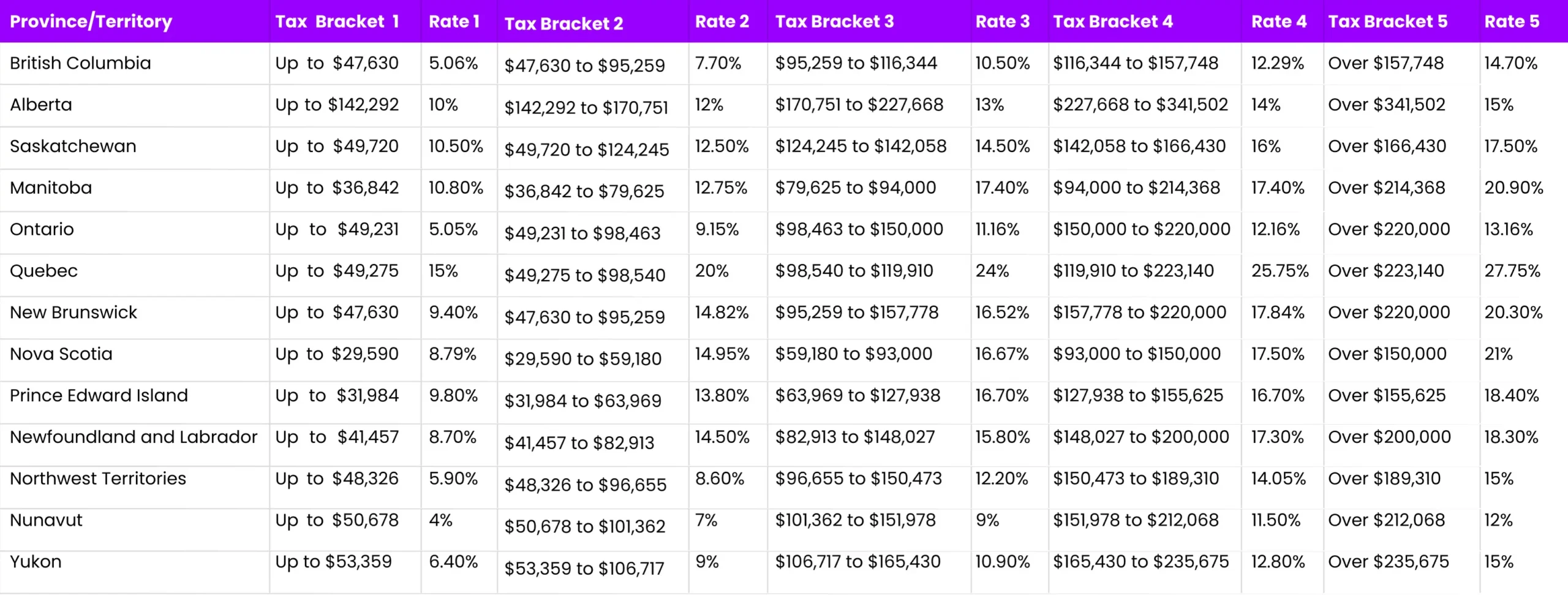Understanding the Canadian tax brackets for 2024 is essential for individuals and families planning their finances. Taxes in Canada are progressive, meaning the more you earn, the higher your tax rate becomes.
However, taxes are not applied uniformly to all income; instead, income is divided into brackets, and each bracket is taxed at a different rate.
Let’s look at the 2024 tax brackets in Canada, explaining how they work, the federal and provincial rates, and how they affect various income levels. Additionally, we’ll offer practical tips for tax planning to help you optimize your tax liabilities for the year ahead.
What Are Tax Brackets in Canada?
Canada employs a progressive tax system. This system ensures that individuals pay a higher percentage of their income in taxes as they move into higher income brackets. However, this doesn’t mean that your entire income is taxed at the highest rate. Instead, different portions of your income are taxed at varying rates according to the applicable tax bracket.
In Canada, both federal and provincial governments levy income taxes. As a result, taxpayers are subject to both federal and provincial/territorial tax brackets, which vary depending on where you live.
Federal Tax Brackets for 2024
For the 2024 tax year, the federal government has adjusted tax brackets based on inflation and other economic factors. Below is a breakdown of the updated federal tax brackets and rates:
| Federal Income Bracket | Tax Rate (2024) |
|---|---|
| Up to $53,359 | 15% |
| $53,359 to $106,717 | 20.5% |
| $106,717 to $165,430 | 26% |
| $165,430 to $235,675 | 29% |
| Over $235,675 | 33% |
These tax rates apply to the portion of income within each bracket. For example, if you earn $60,000 in 2024, the first $53,359 will be taxed at 15%, and the remaining $6,641 will be taxed at 20.5%.
Provincial and Territorial Tax Brackets for 2024
In addition to federal taxes, each province and territory in Canada has its own tax brackets and rates. Below is an example for Alberta (which has a flat tax system) and Ontario (which uses a progressive system).
Alberta (2024)
| Alberta Income Bracket | Tax Rate (2024) |
|---|---|
| Up to $142,292 | 10% |
| $142,292 to $170,751 | 12% |
| $170,751 to $227,668 | 13% |
| $227,668 to $341,502 | 14% |
| Over $341,502 | 15% |
Ontario (2024)
| Ontario Income Bracket | Tax Rate (2024) |
|---|---|
| Up to $49,231 | 5.05% |
| $49,231 to $98,463 | 9.15% |
| $98,463 to $150,000 | 11.16% |
| $150,000 to $220,000 | 12.16% |
| Over $220,000 | 13.16% |
Note: Other provinces have different brackets and rates. It’s crucial to verify the current year’s tax brackets for your province or territory to ensure accurate tax calculations.
How Marginal Tax Rates Work
The concept of marginal tax rates is central to understanding how income tax works in Canada. A marginal tax rate is the percentage of tax applied to your next dollar of income. This means that:
- The first portion of your income is taxed at the lowest rate.
- As you move into higher brackets, each additional portion is taxed at a higher rate.
For example, if you earn $100,000 in Alberta, your income is taxed as follows:
| Income Portion | Marginal Tax Rate |
|---|---|
| First $53,359 | 15% (federal) + 10% (provincial) = 25% |
| $53,359 to $98,463 | 20.5% (federal) + 10% (provincial) = 30.5% |
| $98,463 to $100,000 | 20.5% (federal) + 12% (provincial) = 32.5% |
Calculating Your Effective Tax Rate
The effective tax rate is different from the marginal tax rate. It represents the average rate at which your income is taxed across all brackets.
The formula for calculating the effective tax rate is:
Effective Tax Rate= Total Tax Payable ÷ Total Income ×100
Let’s assume you earn $100,000 and live in Ontario. Here’s a breakdown of the taxes you would pay:
| Income Portion | Federal Tax | Ontario Tax |
|---|---|---|
| First $49,231 | $7,384.65 (15%) | $2,484.17 (5.05%) |
| $49,231 to $98,463 | $10,081.43 (20.5%) | $4,495.11 (9.15%) |
| $98,463 to $100,000 | $405.23 (20.5%) | $171.41 (11.16%) |
| Total | $17,871.31 | $7,150.69 |
Thus, the total tax payable is $25,022. The effective tax rate is:
Effective Tax Rate = 25,022 ÷ 100,000 ×100=25.02%
2024 Canada Provincial Tax Brackets

Example of Tax Calculation for 2024
Let’s walk through an example of how to calculate taxes for a hypothetical individual earning $120,000 in Alberta in 2024.
Step 1: Calculate Federal Tax
- First $53,359 at 15% = $8,003.85
- $53,359 to $106,717 at 20.5% = $10,929.39
- $106,717 to $120,000 at 26% = $3,467.82
Total Federal Tax = $22,401.06
Step 2: Calculate Provincial Tax
- First $142,292 at 10% = $12,000 (since Alberta’s rate for this income range is flat).
Total Provincial Tax = $12,000
Step 3: Add Federal and Provincial Taxes
Total Tax Payable = $22,401.06 + $12,000 = $34,401.06
Effective Tax Rate = 34,401.06 ÷ 100,000 ×100 = 28.67%
Strategies to Minimize Your Tax Liability
There are several ways to minimize your tax liability in Canada legally:
1. Tax Credits and Deductions
Canada offers various tax credits and deductions that can reduce your taxable income or the amount of tax you owe:
- RRSP Contributions: Contributions to a Registered Retirement Savings Plan (RRSP) are tax-deductible. The more you contribute (within the allowable limits), the lower your taxable income.
- Tax-Free Savings Account (TFSA): While TFSA contributions are not tax-deductible, any income earned in a TFSA is tax-free.
- Child Care Expenses: If you have children, you can claim child care expenses to lower your taxable income.
2. Income Splitting
If you’re in a high tax bracket and your spouse is in a lower one, income splitting (such as pension income splitting for retirees) can help reduce your overall family tax burden.
3. Claiming Eligible Medical Expenses
You can claim medical expenses that exceed a certain percentage of your income. This can help reduce the amount of taxes you owe.
4. Charitable Donations
Donating to registered charities entitles you to a non-refundable tax credit. The federal rate for donations is 15% for amounts up to $200 and 29% for amounts over $200.
Conclusion
The tax brackets in Canada for 2024 reflect the country’s progressive tax system, where higher incomes are taxed at higher rates. Understanding both federal and provincial/territorial tax brackets is essential for effective financial planning.
By familiarizing yourself with your marginal and effective tax rates, and by leveraging tax credits, deductions, and income-splitting strategies, you can optimize your tax situation. With proper planning, you can minimize your tax burden and maximize your savings for the future.
As tax rates and brackets are subject to change, it’s important to stay updated with the latest information or consult a tax professional to ensure you are making the most of your tax planning in 2024. You can contact us to create the perfect tax plan for your year. Call us at 780-691-3982 or Email info@yegtaxmasters.com
